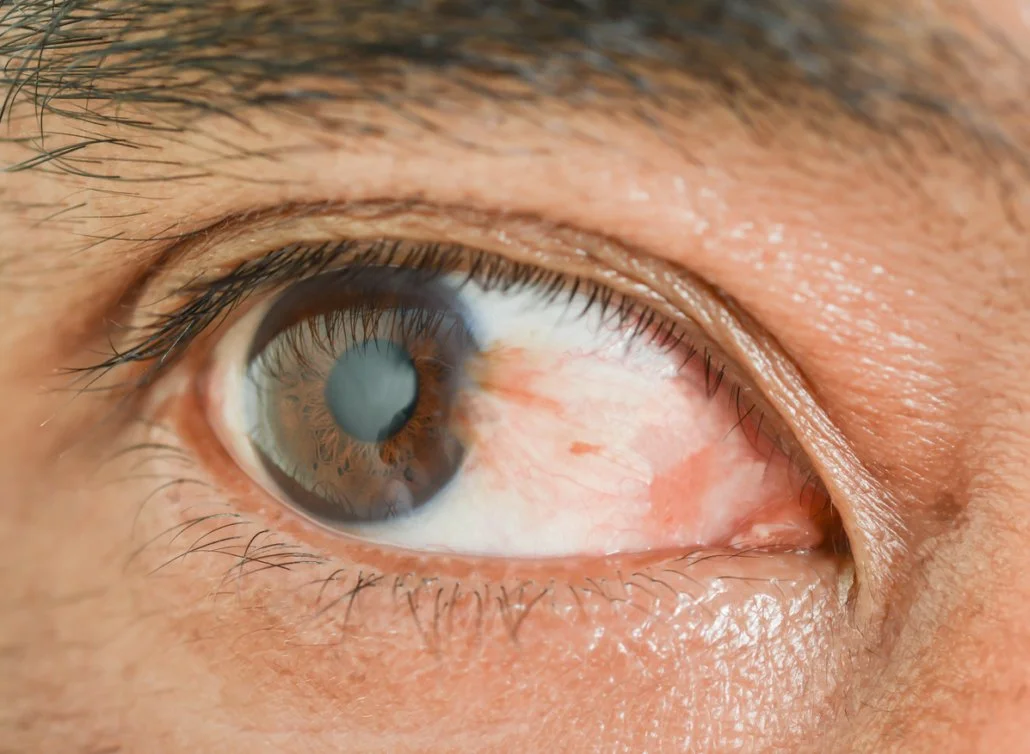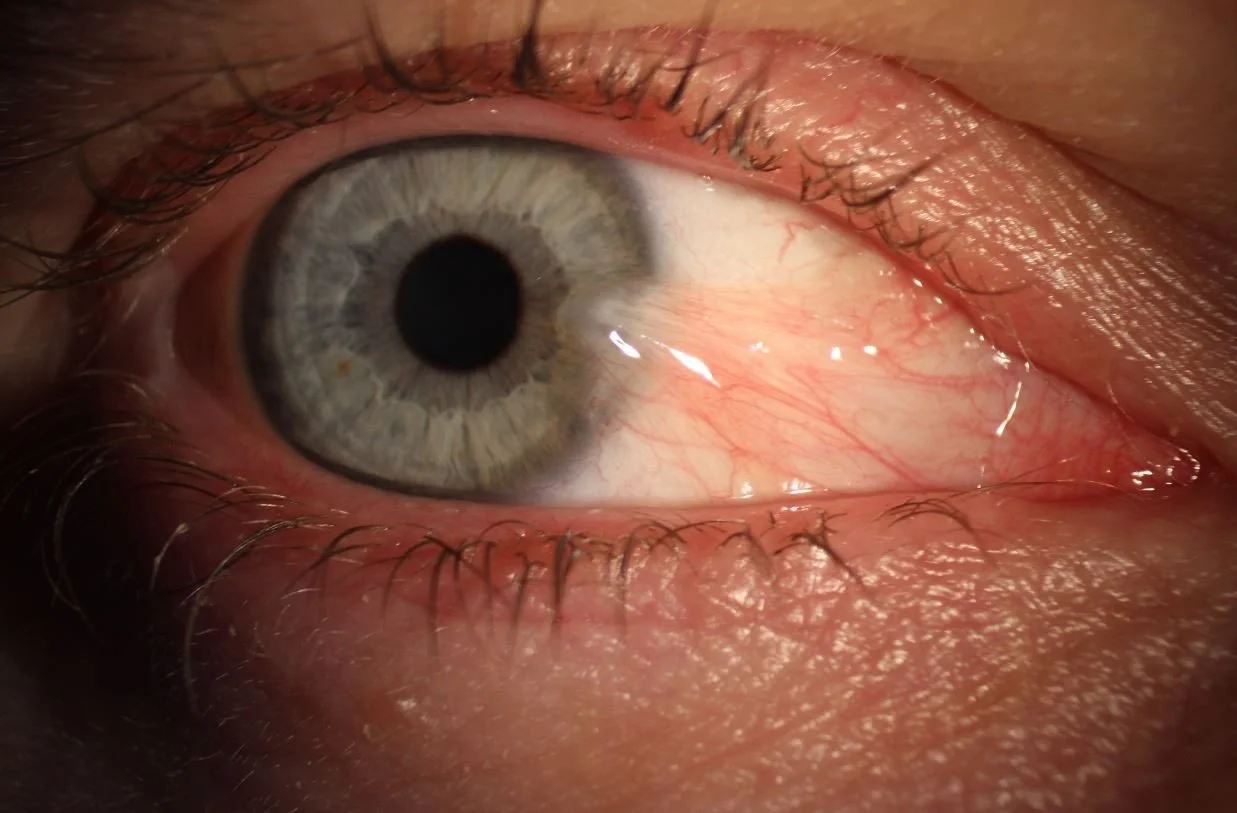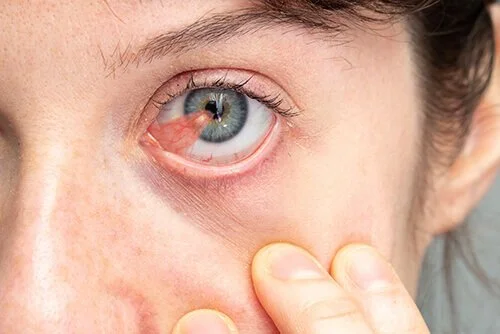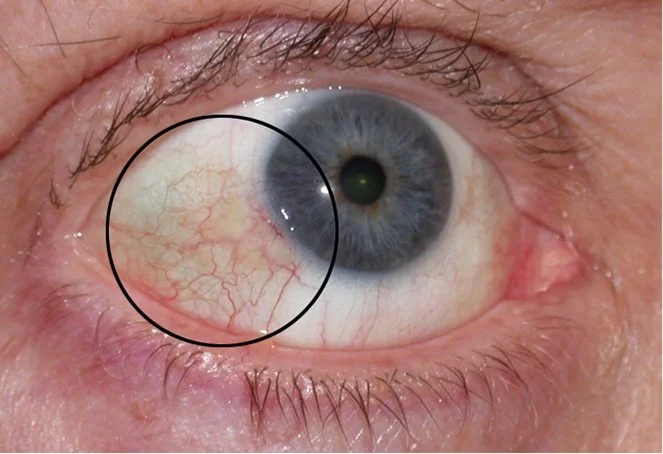Treatment of Pterygium: Causes, Symptoms, Surgery & Prevention Tips
Pterygium, often referred to as “surfer’s eye”, is a wedge-shaped growth of abnormal tissue that develops on the conjunctiva and extends across the cornea. This condition is generally caused by excessive exposure to environmental elements such as dust, wind, and especially ultraviolet radiation from the sun. Individuals who spend a significant amount of time outdoors without proper eye protection are more likely to develop this condition.
A pterygium typically begins on the inner corner of the eye, near the nose, and may slowly grow toward the outer corner. If left untreated, it can progress into the visual axis, potentially affecting vision and leading to permanent vision problems.
Some risk factors that increase the likelihood of developing a pterygium include living in sunny climates, having a history of long-term exposure to UV light, and working in dusty or windy environments. This is why wearing a wide-brimmed hat and sunglasses is recommended to protect your eyes.
Common Symptoms and When to See a Doctor
The symptoms of a pterygium can vary depending on its size and growth rate. In many cases, it causes only minor irritation and does not require immediate treatment. However, some individuals experience significant discomfort and vision issues.
Common symptoms include:
Foreign body sensation – feeling like there is something in your eye.
Chronic irritation – redness, dryness, or itchiness that doesn’t go away.
Visual disturbances – blurriness or reduced vision if the pterygium grows onto the cornea.
Noticeable blood vessels in the affected area.
If the pterygium grows large enough to cover the visual axis, causes severe discomfort, or is cosmetically concerning, an ophthalmologist may recommend surgery. Early diagnosis, facilitated by a slit lamp examination, can help determine the most effective treatment options.
Treatment Options for Pterygium
Observation and Monitoring – If the growth is small and symptoms are minimal, the best approach may be regular check-ups to ensure it doesn’t progress.
Lubricating Eye Drops – Artificial tears can help relieve dryness and irritation caused by the growth.
Steroid Eye Drops – A short course of steroid medication may be prescribed to reduce inflammation and redness.
Surgical Removal – If the pterygium is affecting vision, causing significant discomfort, or for cosmetic reasons, pterygium surgery may be performed.
Conjunctival Autograft – This surgical treatment involves replacing the removed tissue with a graft from another part of the conjunctiva to reduce recurrence.
Understanding the Causes and Diagnosis of Pterygium
The treatment of pterygium often begins with identifying what causes a pterygium in the first place. This eye condition is strongly linked to environmental factors, including prolonged exposure to ultraviolet light, dusty surroundings, dry climates, and wind. People living in sunny or rural areas, or those who work outdoors, are more likely to develop this wedge-shaped growth due to these constant irritants.
A pterygium diagnosed in its early stages is easier to manage and may not require immediate surgery. Eye specialists typically use a slit lamp examination to check the growth’s size, location, and impact on the cornea. If the growth is small and symptoms are mild, treatment may focus on managing irritation and preventing further progression.
However, if the pterygium grows larger, begins affecting vision, or causes cosmetic concerns, your ophthalmologist may recommend having the pterygium removed. Early detection and understanding the role of environmental triggers are essential steps toward effective prevention and management.
Pterygium Surgery and Surgical Removal Procedure
When a pterygium grows too large or begins affecting vision, surgical removal becomes the most effective treatment option. This surgical treatment is generally done under local anesthesia and is a safe, outpatient procedure. During surgery, the abnormal tissue growing onto the cornea is carefully removed, and in many cases, a conjunctival graft is placed to cover the area. This technique significantly helps in preventing pterygium recurrence.
For most patients, pterygium surgery is performed for both functional and cosmetic reasons. While surgery removes the growth entirely, there is still a small chance of regrowth, especially if long-term exposure to UV radiation continues. To reduce this risk, doctors often advise protecting your eyes from ultraviolet light and avoiding dusty environments after the procedure.
Post-Surgery Care and Pain Relief
Pain Relief – Over-the-counter pain medication or prescription drops may be provided for comfort.
Steroid Eye Drops – Used for a few weeks after surgery to control inflammation and reduce redness.
Prevent Infection – Antibiotic eye drops are prescribed to protect against bacterial contamination.
Follow-Up Visits – Regular check-ups to ensure healing and detect any signs of regrowth early.
Sun Protection – Wearing UV-protective sunglasses and a wide-brimmed hat outdoors.
Preventing Pterygium Recurrence
While pterygium removal is effective, the condition can recur if preventive steps are not taken. The most important measure is minimizing UV radiation exposure by using sunglasses that block ultraviolet light. People who spend a lot of time outdoors should also wear protective eyewear in windy, dusty environments to reduce chronic irritation.
Maintaining good eye health includes using lubricating eye drops to keep the eye surface moist, especially in dry climates. Avoiding long-term exposure to irritants and wearing a wide-brimmed hat can also help prevent new growths from forming. Early detection through routine eye check-ups allows for timely management before the pterygium grows into the visual axis and threatens vision.
Long-Term Outlook and Managing Untreated Cases
Remain Small – Some pterygia stay small and cause only minimal irritation.
Progressive Growth – Without intervention, the growth can extend across the cornea and interfere with vision.
Permanent Vision Problems – Large, untreated pterygia can cause lasting vision impairment.
Pterygium Treatment Depends – On factors such as size, symptoms, and the patient’s overall eye health.
Early Action Recommended – Early diagnosis can prevent the need for more invasive surgery later.
Conclusion
Pterygium is a common but preventable eye condition primarily caused by ultraviolet radiation and environmental factors. Although it often starts as a minor irritation, it can lead to serious, permanent vision problems if left untreated. Modern pterygium surgery with conjunctival autograft has made surgical removal safer and more effective than ever, with a lower recurrence rate.
Protecting your eyes by wearing sunglasses, using steroid eye drops when prescribed, and avoiding prolonged sun exposure are key to both prevention and recovery. Whether you have a small growth that only needs monitoring or a larger one requiring surgical intervention, timely care is the best way to preserve clear, healthy vision.





